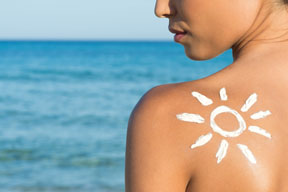| << Back |
Feeling Fit: SunSmart IQ – The Truth About Sunscreen SPF
By Doe Girling
Back in the 1950s and 1960s, sunscreen ad campaigns promoting bronzed, sun-kissed skin started the sun worshipping craze in this country. Remember the ever present Coppertone ads featuring that cute, blond girl with a dog pulling her bathing suit bottom down? Well, the sad truth is that cute blued-eyed girl probably now has leathery skin or is one of the 76,250 people diagnosed annually with malignant melanoma cancer.
Thankfully, we have become more educated in recent years about the importance of wearing sunscreen to avoid getting skin cancer as well as to help our skin age more gracefully. But even with this information, how SunSmart are we? With the rise in skin cancer, manufacturers have hopped on the SPF bandwagon, and over the past several years they have added SPF protection to myriad products. Still, are we being lulled into a false sense of SPF security? Here is some info that may help elevate your Sun IQ.
Rules and Regulations
The sunscreen industry in the United States has unfortunately not changed its standards since the mid 1970s. Manufacturers face little restriction in making claims about their products and do not have to disclose whether or not their products provide broad spectrum protection or water resistance capabilities. For products featuring an SPF lower than 15, there is no obligation to warn users that the product does not help prevent sunburn, skin cancer or early skin aging. “Buyer beware” is the phrase that comes to mind here, as the scarcity of regulation could lead to unintentional deadly consequences.
Unlike the United States, Australia forced their sunscreen manufacturers to raise their standards in response to an epidemic skin cancer rate in the mid 1970s. As a result, studies Down Under have shown a decrease in skin cancer that can directly be attributed to a stringent public service campaign called “Slip, Slap and Slop”… Slip on a shirt, slap on a hat and slop on sunscreen. Australian sunscreens have the highest standards worldwide, and their efforts stand as a sharp contrast to the approach to marketing sunscreen in the States. As such, it’s important for Americans to be educated.
SPF Specifics
Most consumers would be surprised to learn that wearing sunscreen with anything higher than SPF 30 provides only a fraction more protection. SPF 15 blocks out 94% of harmful UVB rays, while SPF 30 blocks out 97% and SPF 50 blocks out 98%. You should know that anything over SPF 50 provides no additional protection, and the FDA has recommended that products advertising 60, 70 or 100 SPF protection be labeled as *SPF 50+ and contain the following disclaimer: “FDA does not have adequate data demonstrating that products with SPF values higher than 50 provide additional protection.”
Equally misleading are the marketing ploys of cosmetic companies that entice you into buying creams, lotions and makeup with SPF protection. Few if any of these products inform you that they must be re-applied every one-and-a-half to two hours. To be safe with an SFP makeup, for example, you need to re-apply your foundation every two hours. That’s a daunting task for most people, and unless you’re willing to comply, you are putting unnecessary chemicals on your face and only getting minimal protection at best.
Cosmetics that contain SPF are often intended by manufacturers to be used both day and night, but why do we need to lather extra chemicals on our body that protect us from the sun while we sleep? Common sense says we don’t, but SPF has become an industry buzzword much like the words anti-oxidant, hypoallergenic and organic. The “buzz” is that most cosmetic companies include SPF to lure their customers into a false sense of SPF security and convince them that using their product will help prevent skin cancer.
The More You Know…
Until the FDA can help get realistic, concrete legislation passed through Congress that establishes higher standards for sunscreens and their manufacturers, keep yourself informed and try not to get “burned.” Here are some easy ways you can be SunSmart:
- Look for sunscreens set to Australian standards. This is currently the only way to be absolutely certain that a sunscreen is held to the highest testing values.
- Be aware of cosmetics that contain SPF and make an informed decision about whether to use them.
- Instead of cosmetic products that contain short-term SPF protection, look for free standing face and body sunscreens with a minimum SPF of 15.
- Don’t be fooled by a product touting extra protection for an SPF over 50.
Protecting our skin from the sun is one of the most important things we can do. By educating yourself about the necessities of sunscreen and being informed enough to recognize misleading product claims, you can stay fit and healthy in the sun this summer.
________________________________________________________________________
Doe Girling is a pharmaceutical skin care professional and a former fundraiser for the Hoag Cancer Institute in Newport Beach, CA. For more information regarding sunscreens and sun safety, you can contact Doe at AboutFaceOC@gmail.com








